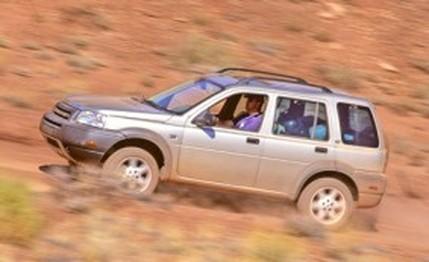
 First Drive Review
First Drive Review
Our digestive centers had barely settled from the rock-hopping adventure staged by Jeep for its new Liberty light off-roader when Land Rover -- the world's other preeminent four-wheeling authority -- invited us to have a go at its entry in the same intensifying small, light-duty-SUV segment.
The contrast was striking. The all-American Jeep retained its robust rear/4-wheel-drive low-range and live-rear-axle setup, sacrificing little in off-road capability for added refinement and gaining little in fuel economy and performance. In order to sell strongly in Europe, however, Land Rover needed to take a lighter approach with its Freelander. So it ditched the separate chassis -- live axles, transfer case, and all -- for a tidy unibody design with long-travel struts at all four corners (offering seven inches of front wheel travel, eight in the rear). A combination of traction control, Hill Descent Control, and grippy tires helps maintain progress through the bush, but without a low range, some trails are off-limits to the Freelander.
End result? The two trucks are sized within a half-inch in length and width (the Jeep is 1.5 inches taller), but the Freelander weighs almost 500 pounds less than a comparable V-6 four-wheel-drive Liberty.
Land Rover's approach pays off in on-road refinement. Structural rigidity is impressive, surpassing even the robust Liberty's quoted torsional rigidity figures (13,000 pound-feet per degree, to Jeep's 8,900). Front and rear subframes isolate the suspension and engine from the body so that a bit of wind noise becomes the dominant intrusion at highway speeds. Ride quality is quite good. The steering feels a bit thick and wooden, but the handling is better than expected -- the body rolls like any other SUV's, but the tires hang on in stoic silence under fairly high cornering loads.
Astute readers know that the Freelander is not new. It went on sale in Europe in 1997 in both three- and five-door trim with a five-speed manual and a choice of gas or diesel four-cylinders. Those choices were unmarketable here, but they made the Freelander the bestselling sport-ute in Europe. Now, a 175-hp, 2.5-liter Rover V-6 engine mated to a five-speed Jatco automatic with BMW Steptronic quasi-manumatic shifting makes the littlest Landie ready for prime time. The five-door arrives stateside this fall.
But wait, you exclaim, why all the Rover and BMW stuff, now that Ford has taken the reins? Sadly, it takes longer to develop a drivetrain application than 18 months from buyout to rollout. Part of the purchase agreement with BMW includes contracts to trade engines and other parts, including the current drivetrain, for two years at least. After that, we sincerely hope Ford will install a 3.0-liter Duratec engine, perhaps even with some of the Jaguar go-fast bits, under the Freelander's hood.
The Rover motor strains a bit and requires frequent downshifts to maintain brisk progress. It gives the Freelander about the same power-to-weight ratio as a RAV4, and its acceleration feels no more urgent. Factory specs suggest a 10.1-second lope to 60 mph, which agrees with our backsides. A long-travel throttle makes the car feel even slower, although it's better for off-roading. Early fuel-economy guesstimates peg the Freelander at 17 mpg city and 22 highway -- slightly ahead of the Jeep.
Okay, so it's a reasonably refined, nimble-handling, efficient trucklet, but just how far into the veld will it carry modern-day Daktaris? Far enough, we suppose. Power is routed aft through a viscous coupling. A slight difference in the overall gear ratios to the front and rear wheels maintains a small speed differential across this coupler, which results in a full-time 95/5 percent front-to-rear torque split that can vary quickly to 50/50 or more with front-wheel slippage. Traction control takes care of side-to-side slippage on each axle.
Underneath, there's 7.1 inches of ground clearance (with the driver aboard; extra loading reduces it) and a fairly sturdy aluminum skid plate to protect the oil pan. Aft of that, a plastic shield keeps mud and gunk from jamming up around the powertrain. Steep approach and departure angles (31 and 34 degrees) keep the chin and tail from dragging too much. And careful drivers can slowly motor through water that nearly covers the tires without risking contamination of the rear differential, transmission, engine, or interior. Hill Descent Control uses the ABS hardware to maintain a 5.6-mph maximum speed when descending steep hills with the gear selector in reverse or low. We motored through deep creeks and up improbably steep dirt hills on trails used by Land Rover to develop the Freelander, and (big surprise!) we didn't get stuck.
Would the Jeep Liberty have managed the same trails? Yep. How about the roomier and more powerful Ford Escape? Maybe. But the Ford owner might never try off-roading, whereas the Land Rover owner will be invited (as often as four times a year) to go on local dealer-organized off-road excursions. Invitations will also come for high-adventure trips to places like Namibia and Borneo. Owning a Land Rover is like being in a club, you see, and the Freelander drops the initiation dues to just below $30,000.
The remaining wild card is quality, which to date has not been the Freelander's strongest suit. But the new Ford management is enthusiastically spending big money to upgrade the factory in Solihull, England. They're also sending every factory worker through the on-site "Land Rover Experience" off-road driving school to build pride in the brand, which may pay even greater dividends than the facility upgrades. We'll know for sure this fall.